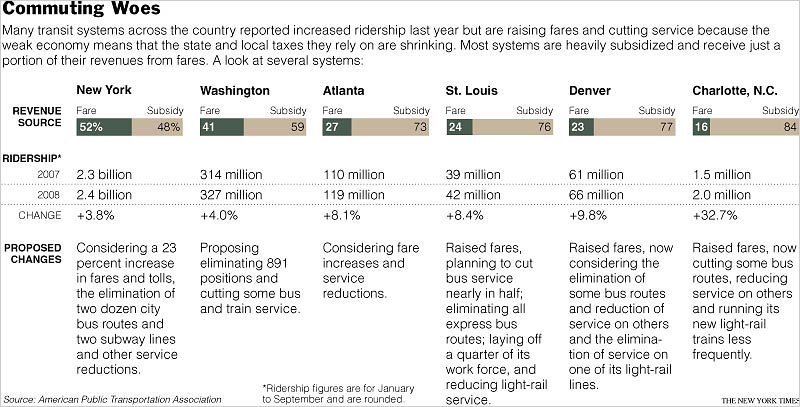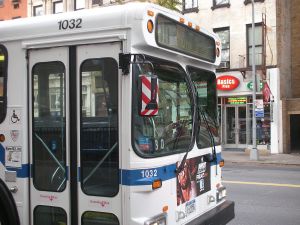Tom McNamara, Blueprint America
Despite an 8 percent increase in ridership last year, in March the St. Louis mass transit system will cut nearly half of its bus service, lay off close to 600 of its workers, and reduce service on its MetroLink light-rail routes.
Vinyl hoods reading, “We regret due to a lack of funding, service to this stop is suspended,” will be draped over transit stop signs where service will be stopped.
Still, when over 70 percent of major transportation – funding measures on ballots this past year were approved throughout the country – injecting some $75 billion into 23 transportation systems – St. Louis voters rejected Proposition M (52 percent to 48 percent ), a half cent sales tax increase that would have gone to fund the city’s struggling system.
A paradox of a problem
Most public transit systems, even in cities that approved funding increases, are also facing substantial budget shortfalls.

Source: The New York Times |
But even as gas prices remain relatively low, Americans continue to ride public transportation at record levels.
According to the American Public Transportation Association (APTA), more than 2.8 billion trips were taken from July through September of last year – an increase of 6.5 percent over the third quarter of 2007. In that time, there was an increase in ridership of 8.5 percent on light rail and streetcars, 7.2 percent on buses, 6.3 percent on commuter rail and 5.2 percent on subways.
In 2007, 10.3 billion trips were taken on U.S. public transit – the highest number of trips taken in fifty years. The final 2008 numbers are expected to be even higher.
Yet, as The New York Times reports, despite the rising ridership demand, the “problem is that fare-box revenue accounts for only a fifth to a half of the operating revenue of most transit systems.” Severe budget deficits for many transit agencies are the result of declining sales and property tax revenues. Now, just to maintain basic operating levels, many transit systems are forced to raise fares and cut service.
‘Hiring a construction worker at the same time you’re laying off a bus driver’
No matter how much is spent on mass transit by Congress with stimulus funds — $12 billion was included in the House version passed last week, while the Senate originally proposed less — these systems across the country will continue to struggle. That is because the new federal money, The New York Times reports, “is devoted to big capital projects, like buying train cars and buses and building or repairing tracks and stations.” Funds to help transit systems pay operating costs, and avoid layoffs and service cuts, have yet to be included in the latest version of the stimulus package.
In other words, as Twin Cities’ regional planning agency Chair Peter Bell recently noted in reference to anticipated cutbacks to the area’s mass transit system, “I’m not sure how much sense it makes hiring a construction worker at the same time you’re laying off a bus driver.”



